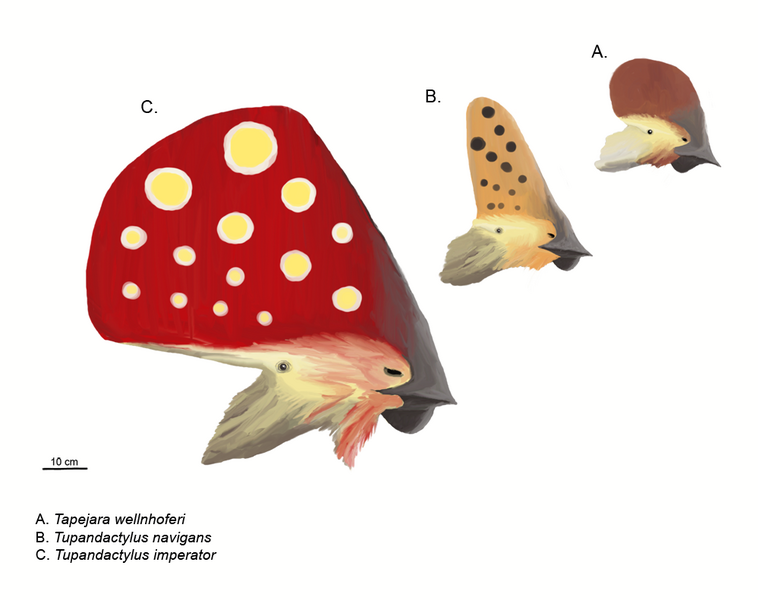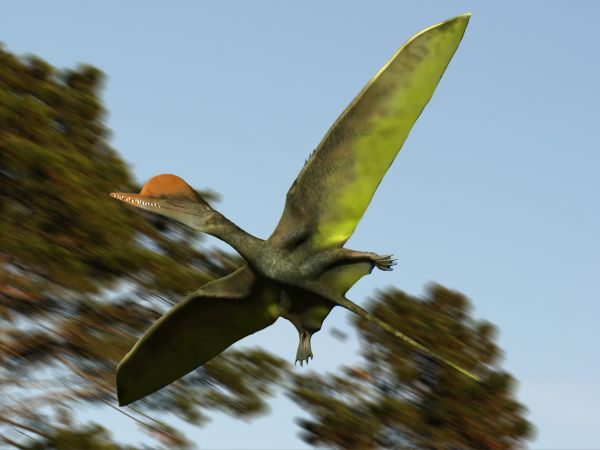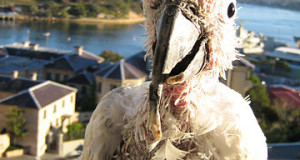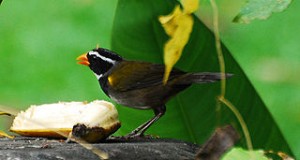 Pterosaurs (incorrectly labeled “Pterodactyls” by old-timers such as I) flew the skies during the Mesozoic Era, some 220-65 million years ago. The huge head crests sported by many have baffled scientists since the first specimen was found in 1784 (please see drawing). However, a recently discovered fossil hints that sexual dimorphism may be involved, and has allowed researchers to determine the sex of fossilized Pterosaurs for the first time.
Pterosaurs (incorrectly labeled “Pterodactyls” by old-timers such as I) flew the skies during the Mesozoic Era, some 220-65 million years ago. The huge head crests sported by many have baffled scientists since the first specimen was found in 1784 (please see drawing). However, a recently discovered fossil hints that sexual dimorphism may be involved, and has allowed researchers to determine the sex of fossilized Pterosaurs for the first time.
Technically, Pterosaurs are flying reptiles, not birds. Yet they possess many bird-like qualities, so I thought that bird enthusiasts might be interested in this latest finding concerning their lives. In any event, taxonomy is constantly blurring the lines between various groups (for example, birds are now considered to be “modern dinosaurs”, and closely related to crocodilians), so perhaps Pterosaur classification may change in the future…
Mysterious Head Ornamentation
Sixteen Pterosaur families are known, with certain species bearing head crests that are up to 5 times the height of their skulls. Those without crests were alternately considered to be juveniles, a different sex or a different species from crest-bearing individuals. Therefore, their taxonomy and natural histories remained cloudy.
Fossil Detective Work
 The finding that led to our most recent peek into Pterosaur life is a Darwinopterus fossil that was found in northeastern China. The specimen bore no crown, and, as it carried a fully-developed, was a female. As other Darwinopterus Pterosaurs do sport large head crests, researchers now believe that the species is sexually dimorphic, with males using the crests to attract mates or intimidate rivals.
The finding that led to our most recent peek into Pterosaur life is a Darwinopterus fossil that was found in northeastern China. The specimen bore no crown, and, as it carried a fully-developed, was a female. As other Darwinopterus Pterosaurs do sport large head crests, researchers now believe that the species is sexually dimorphic, with males using the crests to attract mates or intimidate rivals.
This new information should help in unraveling the natural histories of these interesting creatures, taking us past identification and into an understanding of how they lived and why they disappeared. Harried museum curators may find it a mixed blessing, as Pterosaur collections must now be re-evaluated as to species identity.
How Pterosaurs Lived
Much like modern birds, Pterosaurs had hollow bones and keeled breastbones to allow for the attachment of powerful flight muscles. Brain, lung and skeletal adaptations parallel those evolved by birds as well. Once believed to be gliders, it is now clear that Pterosaurs were capable of actual flight.
The many species that have been identified exhibit a great diversity of forms and apparent lifestyles. Sporting wingspans ranging from 9 inches to 35+ feet, the toothed jaws of some species evolved into long, bird-like beaks. An analysis of beaks, feet and skeletons indicates that various Pterosaur species fed in a similar manner to flamingoes, albatrosses, puffins, herons and other modern day birds.
Quetzalcoatus, the largest known flying animal, had wings that spanned 35 feet and may have weighed in excess of 500 pounds (please see artist’s recreation). Much like today’s storks and cranes, it is believed to have stalked small animals on land.
Further Reading
Video: Installing a Pterosaur model
Pterosaurs: Lords of the Sky (National Geographic Magazine)
Pterosaur facts (including movie appearances)
Darwinopterus image referenced from wikipedia and originally posted by Nobu Tamura
Reconstructed profiles of three tapejarine pterosaurs image referenced from wikipedia and originally posted by Matthew Martyniuk
Quetzalcoatus foraging image referenced from wikipedia and originally posted by Mark Witton and Darren Niash
 That Bird Blog – Bird Care and History for Pet Birds
That Bird Blog – Bird Care and History for Pet Birds


